Affiliate disclosure: This post may contain affiliate links. Please see our Privacy Policy.
Eastern prickly pear cactus (Opuntia humifusa) is a cold-hardy cactus native to the Eastern United States. It’s hardy to zone 4 (-30 F), which means almost anyone can grow prickly pear fruits at home (even outside the desert).
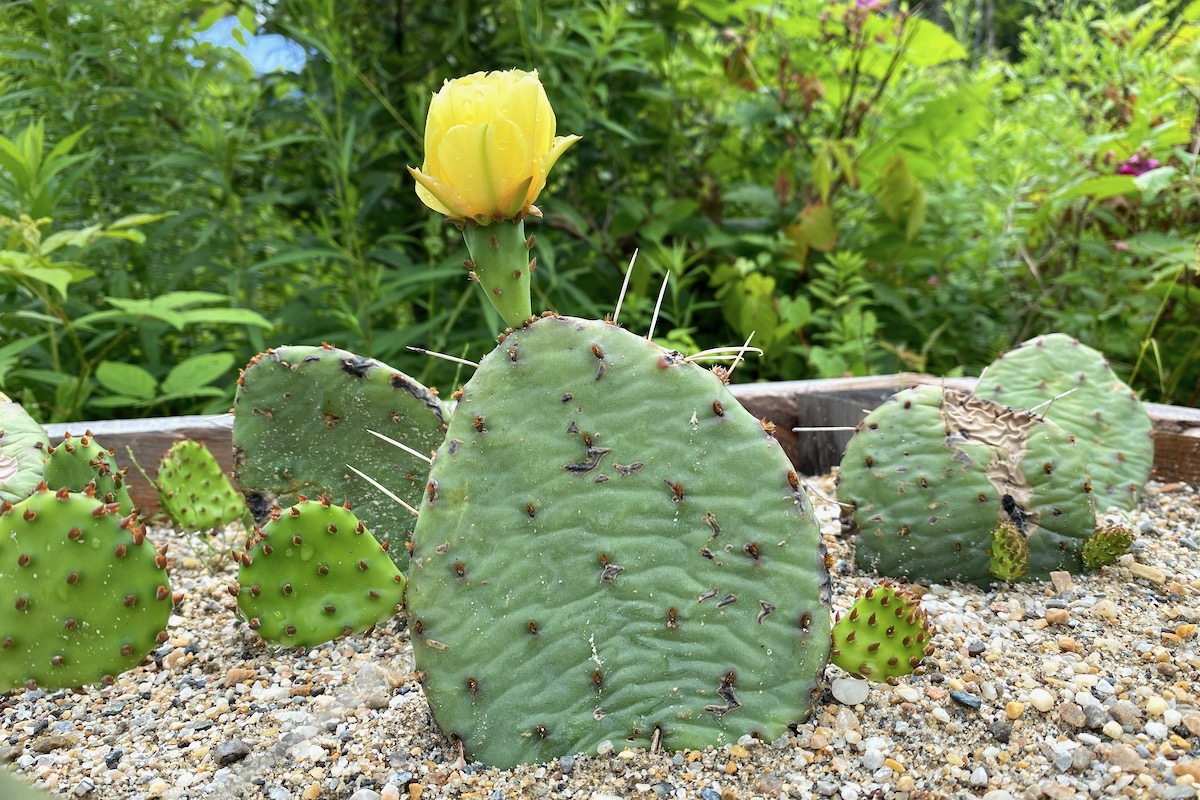
Our homestead is our garden playground, and we try to grow as many different varieties of fruits and vegetables as possible on our plot. Our goal is to be able to provide for all our fruit needs year round from our permaculture orchard, whether it be from fruits that ripen early (or late), as well as hardy storage varieties like these storage apples.
We grow literally dozens of types of cold-hardy fruits, including unusual fruits like honeyberries, thimbleberries, salmonberries, and shipova. We also grow all manner of perennial vegetables and we even grow cold-hardy peaches and cold-hardy nut trees.
You don’t have to live in a warm climate to grow diverse crops, you just have to do your research and find the right varieties. In this particular case, we’re growing a cold hardy cactus variety that we found from Prarie Moon Nursery.
Vermont isn’t exactly known for its cactus, but believe it or not, there are cactus species that are both cold-hardy and native to the East Coast.
Eastern prickly pear cactus grows in dry sandy spots all over New England, and though those types of soils are not all that common in backyard gardens, it’s easy enough to create a small cactus box to grow your own prickly pear fruits even in the far north.
I grew up harvesting prickly pear out of my grandfather’s back yard in the Mojave desert, but there wasn’t much else. Now I’m looking forward to harvesting my own northern prickly pear from my cactus garden…not far from where we planted our asparagus, and just a stone’s throw away from our homegrown ramps.
It’s amazing how many things you can grow when you really put your mind to it!
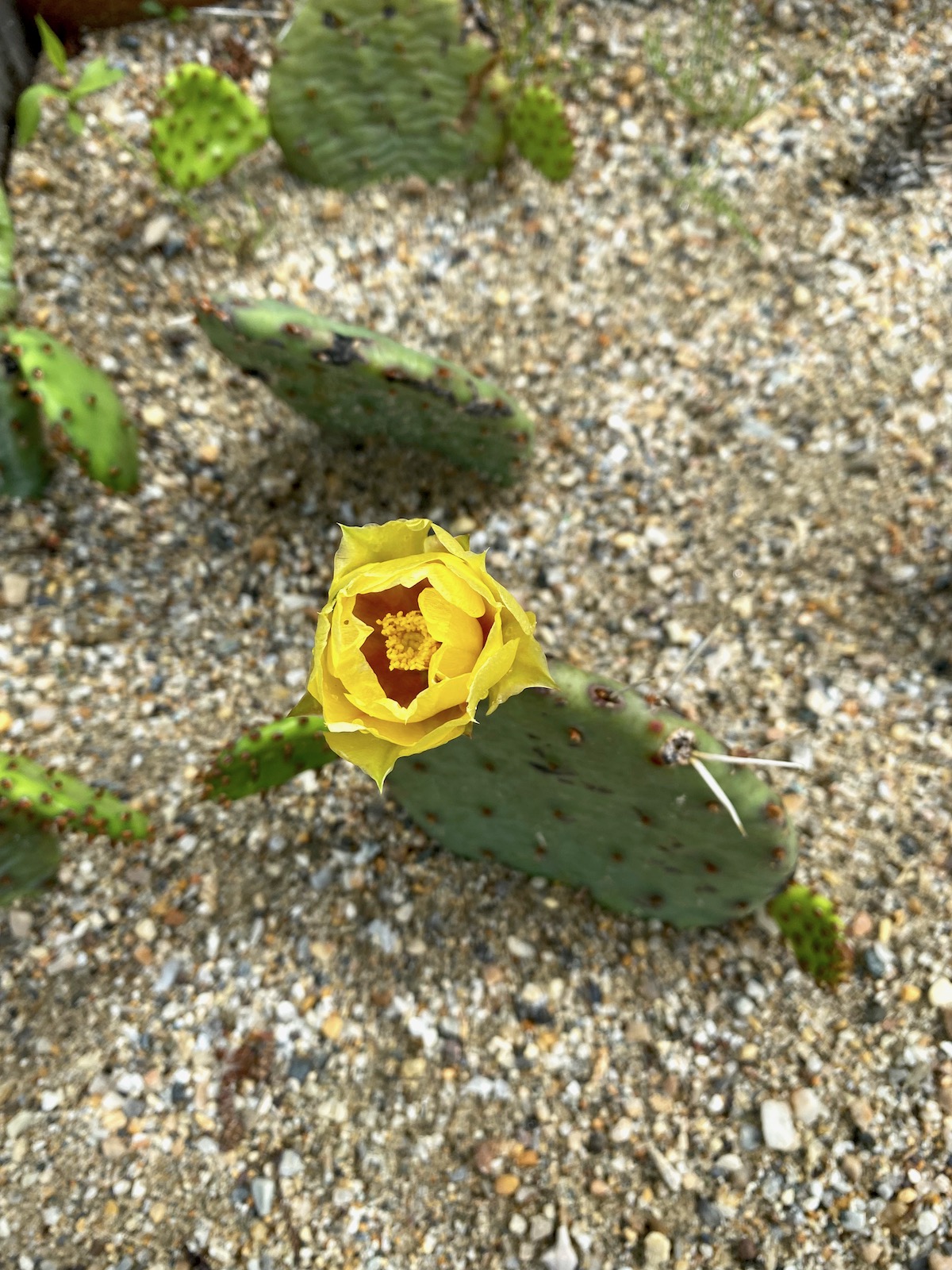
Eastern Prickly Pear Cactus Range
The natural range of Eastern Prickly Pear covers the Eastern half of North America, all the way up into Canada and south into Florida. It’s actually not native to Vermont, largely because our soils are generally fine, rich, and moist with bedrock near the surface. That’s a recipe for moisture retention, and we tend to support natives that like their feet wet…things like highbush cranberry, nannyberry, and wild gooseberries.
Still, with a little preparation you can create the right soil for them…namely straight sand with good drainage and very little organic matter.
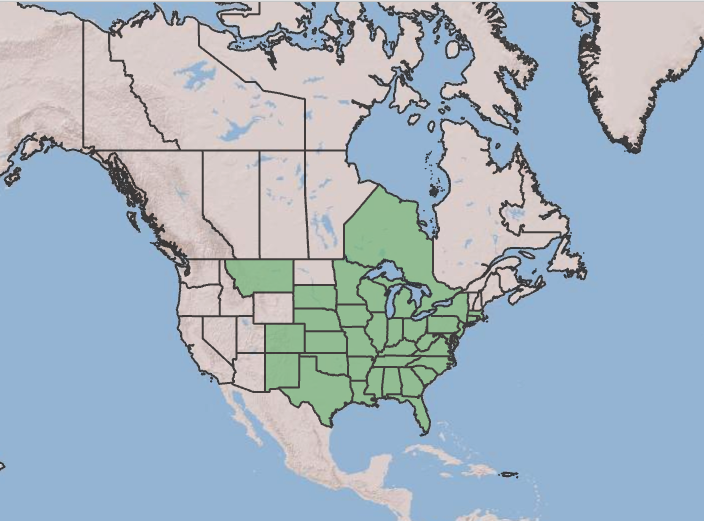
Where to Buy Eastern Prickly Pear Cactus
We ordered cactus pads from Prarie Moon Nursery, and they arrived in the spring around the same time as our bare root strawberry plants for replanting our everbearing strawberries. The cactus pads cost about $4 to $5 each, depending on how many you order. I ordered quite a few, assuming I’d not all of them would survive…but they did.
My husband calls them my expensive pet, and they are more or less a pet to me. I watched them all summer, and I would have to pet them if they weren’t so spiky. I’m just so enamored with the fact that I’m growing cactus in zone 4!
They all did so well that they’re now crowding their space, and I’m going to have to transplant many of them to a new box.
They also sell seed packets, though I don’t have experience with those.
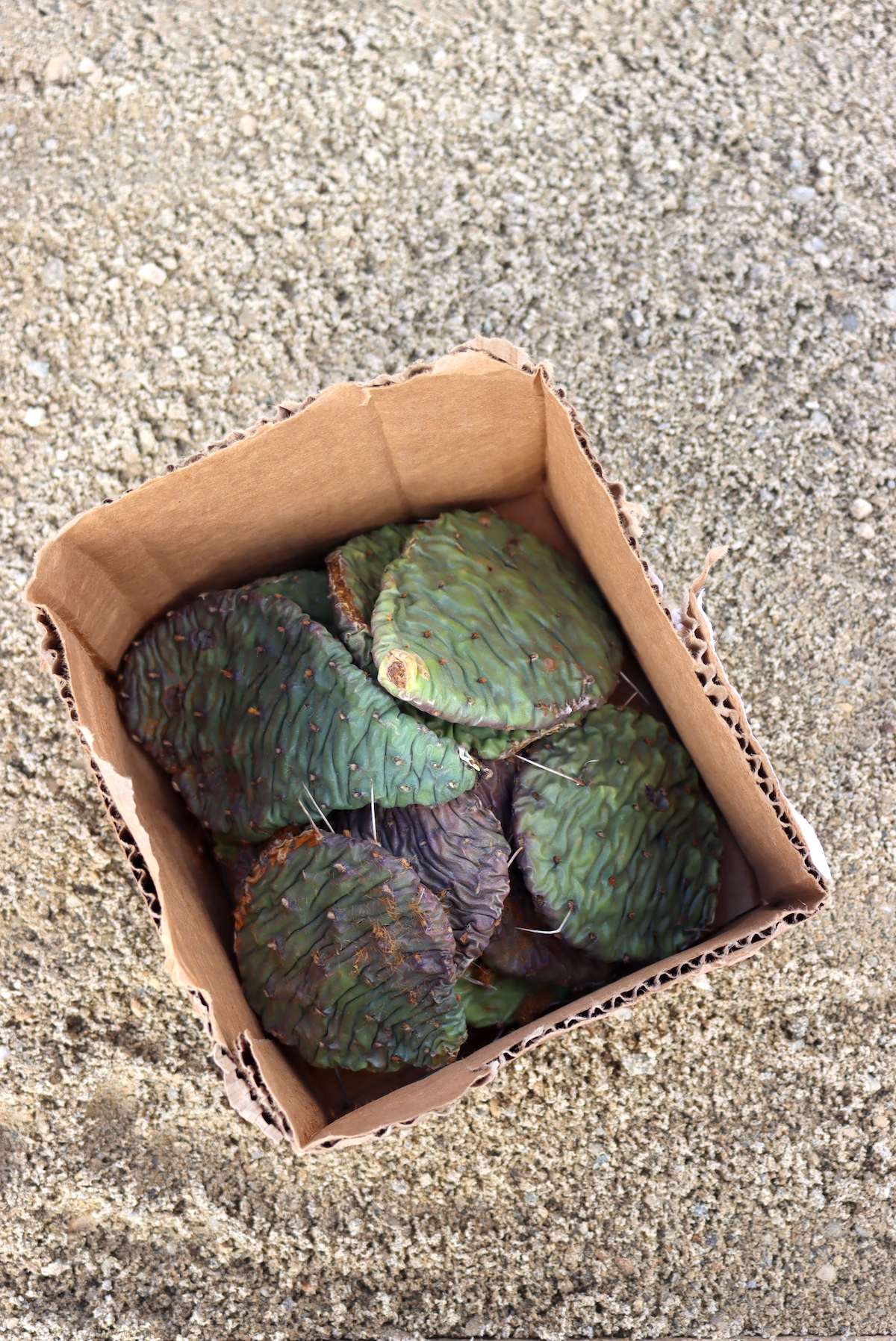
How to Grow Eastern Prickly Pear Cactus
The instructions from Prarie Moon Nursery are pretty straightforward. Simply plant the pads cut side down in the sand. That’s it.
When we created a planter for growing lingonberries, which also like sandy soil (though in their case a mixture of sand, peat, and compost), I simply dug sand out of the beach of our homestead pond. There’s plenty of it, and more is always washing in.
This time though, the pads arrived early in spring and the pond was still full, and had patches of ice on top in places. I wasn’t excited about wading out to dig sand in icy water, so I picked up a few bags of washed play sand (sandbox sand) from the hardware store.
I only needed two bags for my small cactus raised bed, but I picked up extra to mulch in other trailing crops at the same time. When you’re growing cranberries, they really benefit from being mulched with sand during their dormant season (late fall through early spring). Our cranberry beds have been ignored too long, and by the time I can dig sand from the pond in spring, it’s too late to mulch them as they’re already putting on their spring flowers.
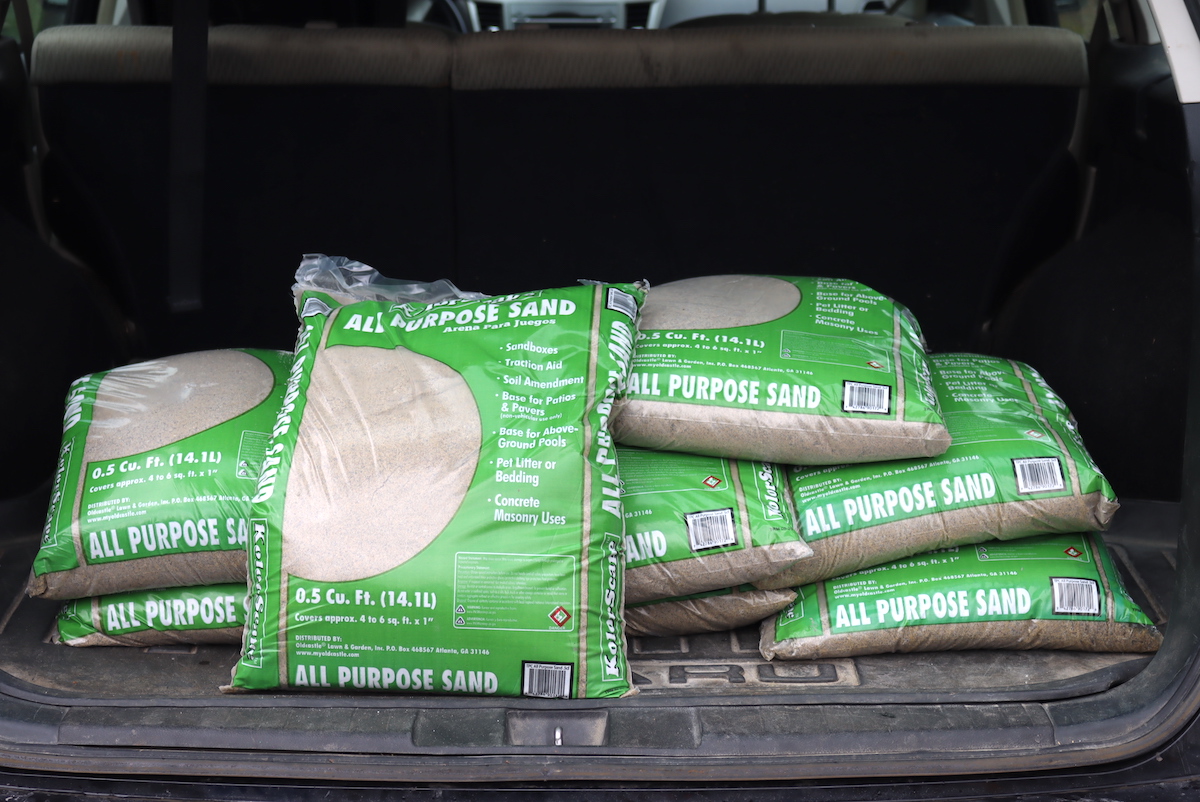
Next up, I put together a small planter box and filled it with sand. We’ve built dozens of 4×8 planter beds this year, and they’re all made out of 12” wide hemlock boards from a local lumber mill. Since our soils are so dense and clay bound, I’ve been building them two high (so they’re 24” deep). If you want to see them, I have some great pictures in my article on growing potatoes in raised beds (the yields were amazing, by the way).
Anyhow, I happened to have some spare end pieces, as often the lumbermill gives us pieces that are way longer than we need. It’s too short for them to sell separately, so we’ll often have an extra 2 to 3 feet of the board to cut off. That’s perfect for making super small planter boxes for our strange crops, or as my husband calls them…my expensive pets.
These pet cactus are growing in a 2×2 foot planter box that’s 12” deep. I filled the bottom 4” with compost, just so they’d have some nutrient reservoir and some water to dig their roots into (if they choose). The top 8 inches is straight sand.
Using gloves, I carefully planted each cactus pad in the sand, burring them about 1” deep.
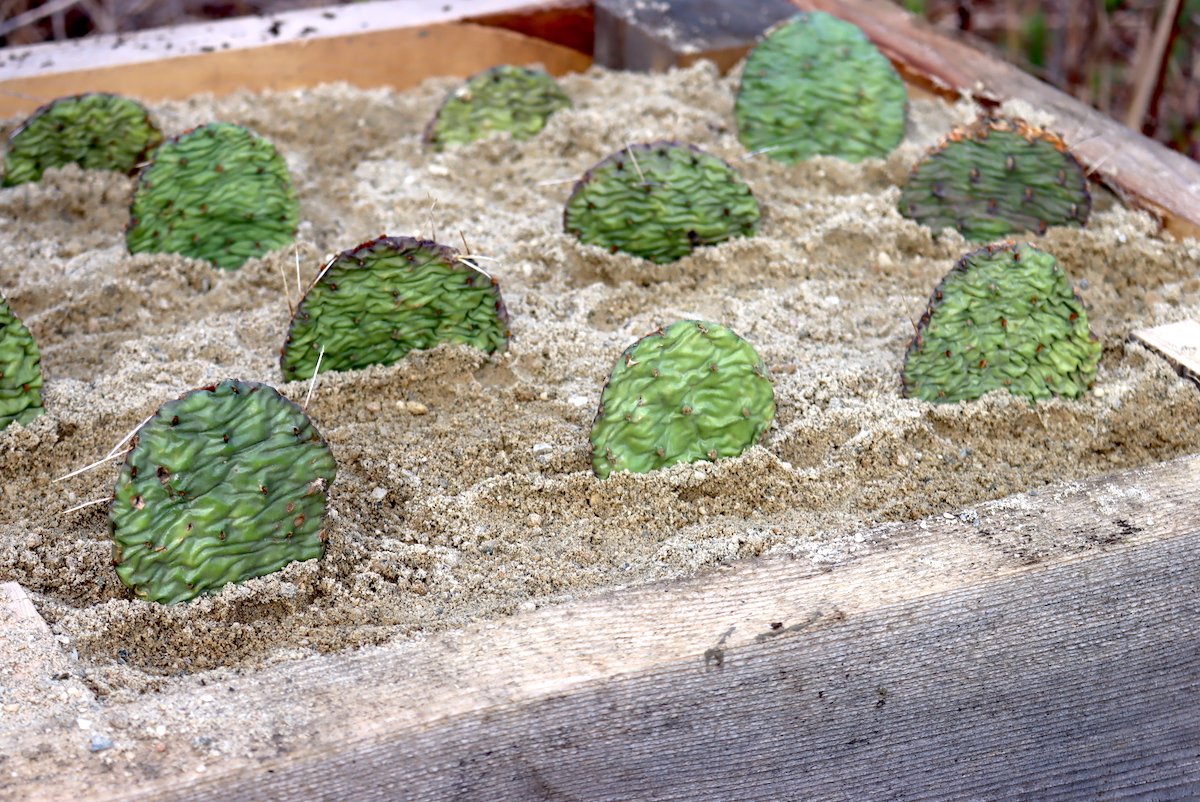
Now I say “wearing gloves” and I’m not kidding. You can see a couple of big cactus spines on there, and those look nasty, but they’re fine. Sure, they’d hurt if you hit one, but they’re easy enough to avoid.
What you really need to watch out for is the very tiny hair-like spines on the pads. They’re so small they look like fluff, but they’re actually small, hairlike spines that are incredibly sharp. Touching those hair-like spines is like touching fiberglass insulation without gloves. You’ll be scratching wherever it touches for days afterward.
Ask me how I know…
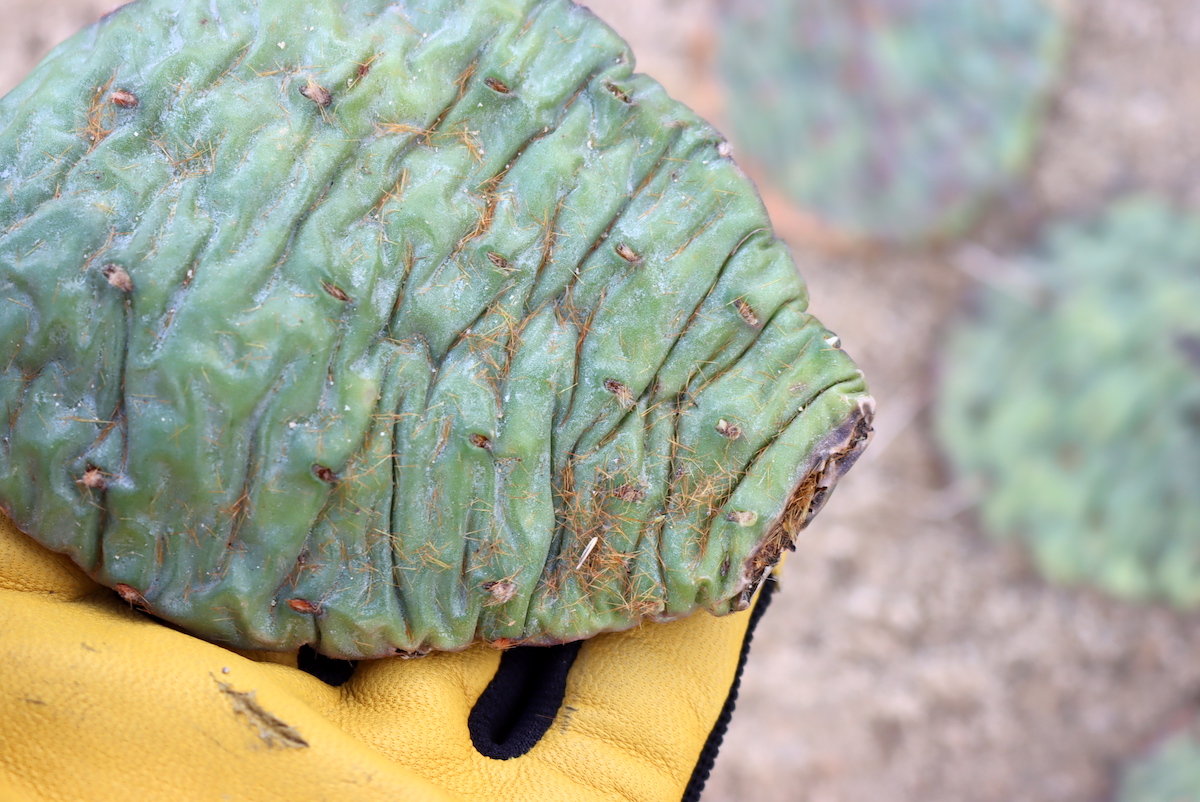
Once they’re planted, you can more or less completely ignore your prickly pear cactus pads. Ours perked up in a few days after planting. We didn’t water them, and it didn’t rain, but they seemed to absorb the morning dew and humidity from the air.
Soon enough they were perky cactus pads, and they’d lost their wrinkles (from dehydration in storage).
They also quickly started sprouting more pads, and one even sprouted a young flower bud within a few weeks of transplant!

Over the course of the summer, I watched that flower develop into a beautiful yellow blossom. The bees loved that bright yellow pollen-filled beauty, but sadly it never developed into a fruit.
I think either the blossoms need cross-pollination from another plant, or my cactus pad was simply too small to support fruit. It’s only a single pad at this point, with a couple of baby side pads growing in…but it’s a lot to ask for it to develop a full-blown fruit in the first season.
Still, they grew so fast and took so quickly that I’m excited to see what next year holds!

This coming year, I’ll transplant some of the pads to a new bed. I planted them quite densely since I expected a low survival rate. Since they all survived, it’s going to get crowded in there.
Eastern prickly pear cactus stays low, growing no more than 1 foot tall. It’ll spread almost like a ground cover over the ground, so the box will be full quite soon.
Its low growth habit is one reason it’s able to survive temperatures well below freezing, as it stays insulated under the snow cover.
Unique Edible Plants
This coming year, we already have more fun edible pets planned. I’m planning on growing yacón (Smallanthus sonchifolius), which is a perennial tuber related to sunflowers. It supposedly tastes sweet and fresh, like an apple. The plant is native to the Andes, and it’s hardy to zone 5. We’re hoping it grows similar to sunchokes, another sunflower relative with edible tubers.
I’m also expanding our strawberry beds to include a dozen different types of alpine strawberry, as well as some unique European native strawberries known as Musk Strawberries. Pineberries and strasberries should round out the planting, so wish me luck.
Looking for more unique fruits to grow in your backyard?
- How to Grow Honeyberries
- How to Grow Husk Cherries
- How to Grow Shipova
- How to Grow Nanking Cherry
- How to Grow Salmonberries
- How to Grow Cornelian Cherry















Thanks for this resource! I can say that after growing PPC from seed and pad, the pad approach is SO MUCH easier (and likely to succeed) FWIW
Yeah, we really liked working with the pads too!
What is the coldest shortest season that prickly pear will fruit in, any variety?
The prickly pear is hardy to zone 4 so as long as you are in zone 4 or higher, you should be able to grow it just fine.
Hi. Am I supposed to take the spikes off my cactus? I don’t need any problems.
Are you asking about removing them when you’re planting them?
Zone 5 here – I started propagating the prickly pear a few years ago – use a river rock growing bed without any interlocking grow media – intermix with some chick & hen for some variety …
My intent is to have another winter green eatable that’ll survive outside the greenhouse – there’s plant volume shrinkage during the winter from dehydration – but the remaining bulk would be a winter bonus ….